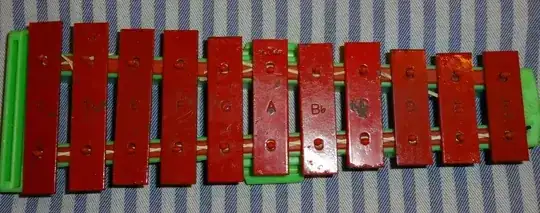As you might already know, frequency of musical notes is arranged in a such a way that if, for example, an A note has frequency of $x$, another A note which is placed one octave higher would produce frequency of $2x$.
So here's my childhood toy glockenspiel:
This is where my question raised. If wave speed inside the bars were the same, as in strings of a guitar, then we would expect two notes that are one octave apart, like the two C's, would have a 2:1 length ratio. But measurement shows that they are designed in approximately 7:5 ratio or maybe $\sqrt2$.
Now I'm wondering what exactly causes this speed variation? Thickness or width doesn't vary meaningfully so it must be about the length but how would length of a bar affect wave speed inside it is what I'm asking here. And why this doesn't happen for strings.
I'll measure and report length, width and thickness of the bars if necessary.
